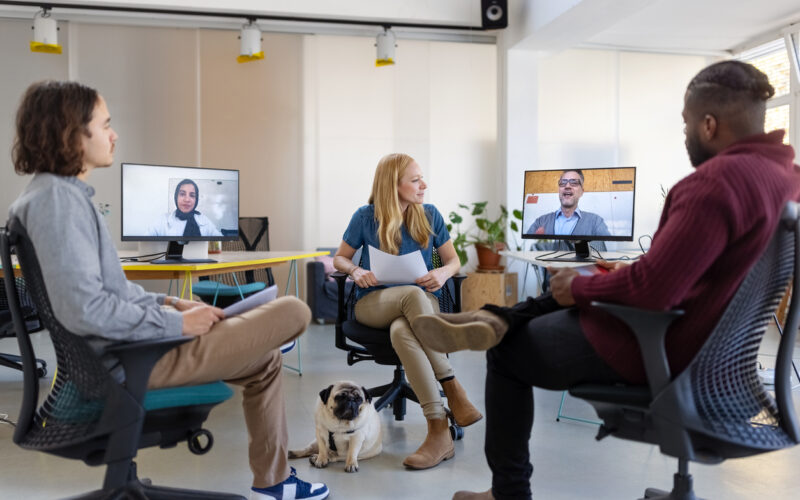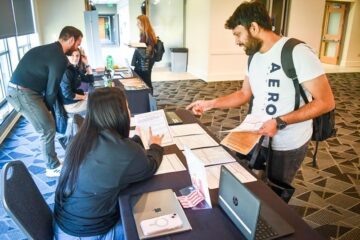Image via iStock
By Isabella Yalif
Many of today’s executives agree on one thing: they really want their workers back in the office. The CEO of Qualcomm once claimed, “I’m a firm believer in the importance of in-person collaboration.” Soon-to-be college graduates, on the other hand, are not that simple. What they want is flexibility and a hybrid work system.
[W]hile the future is hybrid, the framework will mean different experiences for different individuals. Some could be in the office all five days a week, while others remain completely online.
Undoubtedly, the current workforce is transitioning to a majority-hybrid model. A 2021 McKinsey study on organizations whose functions don’t require on-site work found that 90% of the surveyed firms use a hybrid model. At the same time, a PwC study found that 33% of executives plan on having a mix of fully in-person, hybrid, and remote workers. Meaning that while the future is hybrid, the framework will mean different experiences for different individuals. Some could be in the office all five days a week, while others remain completely online.
The biggest problem facing executives attempting to transition to a hybrid model is creating the best system that appeases the most people and their company goals. As New York Times writer Emma Goldberg explains, “Fully remote work is simple enough to dictate, as is fully in person. Hybrid work often creates a conundrum.” The same McKinsey study referenced above revealed that a third of the executives said their leadership team was not aligned on their vision for their hybrid model. Mark Flint, the co-founder and CEO of The Escape Game, shared his experience, saying, “We tried many different versions [of hybrid work] for various periods of time.” Evidently, there is disagreement in the industry over how best to implement this radical change, and constant readjustment in the face of new feedback is necessary.
So, why do employers want to return to an in-person system so badly? The main reasons are culture, productivity, innovation through collaboration, and career development. Melissa Daimler, the Chief Learning Officer of Udemy, said, “We can no longer hide behind free food and ping-pong tables when defining culture.” Culture is developed by spending time with colleagues and constantly strengthened by surrounding oneself with fellow employees.
In terms of productivity, a SHRM study found that the U.S. has now experienced five consecutive quarters of year-over-year declines in worker productivity. A running theory explains this: when working from home, people multitask on non-work related tasks. An example of this is the common phenomena of doing laundry while on Zoom calls. Supporting this conclusion, a Nature study revealed that in-person pairs of workers consistently outperform their virtual counterparts.
Innovation and idea creation through collaboration are proven to decrease when virtual work stifles collaboration. Researchers at MIT found that innovation declined in their virtual work setting, having discovered that weak ties at MIT went down by 38% since the beginning of the pandemic. Weak ties are defined as “casual connections and loose acquaintances” and are proven to lead to innovation. Another study revealed that in-person teams generate up to 20% more ideas than remote teams working on the same issue.
Mentors help their mentees increase communication skills, expand their professional network, identify career goals, shape their leadership style, and a plethora of other future-facing facets.
Finally, employee career development suffers when workers cannot have the same level of conversation with their superiors. The SHRM study found that “in-office workers spent 40 more minutes weekly mentoring others” than remote workers did. The significant difference is linked to differences in future career growth. Mentors help their mentees increase communication skills, expand their professional network, identify career goals, shape their leadership style, and a plethora of other future-facing facets.
Incoming college graduates are more skeptical about in-person work, yet they are open to it. In an A.Team study with 500 upper-level college students, 57% expressed a desire for a flexible hybrid model, compared to only 7% who wanted a fully remote lifestyle.
The key word here is flexible. Students not only want a hybrid work environment but also want the rules of their work schedule to be malleable. Another SHRM study reinforced this point by proving that 69% of juniors said they are more likely to apply for a job if it allows for flexibility in work hours.
After talking with Vanderbilt students, it is clear that flexibility is a requirement at the top of their lists. “For this summer I would only look at a job if they allowed me to have a flexible schedule,” said sophomore Drina Agojci.
College students’ need for flexibility and an option for remote work is not up for debate to many. The same A.Team study revealed that 33% of respondents rated the ability to work remotely as the most important factor when searching for jobs, above even salary.
“Being able to work remotely at least once a week is an absolute must for me.”
Sofia Healy, Vanderbilt University Class of 2027
Looking empirically, Vanderbilt students are steadfast in their determination to not shut the door on remote work. Freshman Sofia Healy expressed her viewpoint, saying, “Being able to work remotely at least once a week is an absolute must for me.”
Thus, as college students enter the workforce, they acknowledge the value of in-person work, yet are unwilling to sacrifice remote work entirely and the flexibility hallmark of many hybrid systems.
As we look to the future of work, there are many questions that employers need to answer regarding how to design the best hybrid system that reaps all the benefits of in-person work while allowing for the flexibility and remote options that young workers covet. There is no set solution for this puzzle. Thus, it can be inferred that a lot of corporate experimentation will follow in the coming years. As such, it is crucial for all incoming workers to be true to themselves as they explore the workforce and decide on a company whose ideas appear to be leading in the same direction as their own. While CEOs might be searching for a solution to the hybrid work puzzle, it may well be new entrants to the workforce who will dictate the future trends of work.




